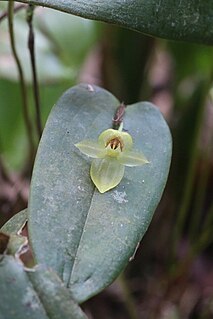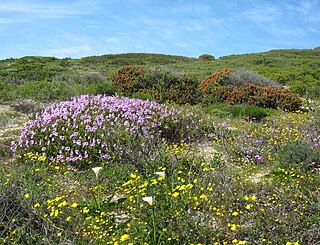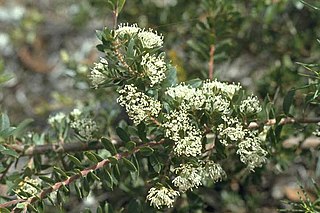
A cactus is a member of the plant family Cactaceae, a family comprising about 127 genera with some 1750 known species of the order Caryophyllales. The word cactus derives, through Latin, from the Ancient Greek word κάκτος (káktos), a name originally used by Theophrastus for a spiny plant whose identity is now not certain. Cacti occur in a wide range of shapes and sizes. Although some species live in quite humid environments, most cacti live in habitats subject to at least some drought. Many live in extremely dry environments, even being found in the Atacama Desert, one of the driest places on Earth. Because of this, cacti show many adaptations to conserve water. For example, almost all cacti are succulents, meaning they have thickened, fleshy parts adapted to store water. Unlike many other succulents, the stem is the only part of most cacti where this vital process takes place. Most species of cacti have lost true leaves, retaining only spines, which are highly modified leaves. As well as defending against herbivores, spines help prevent water loss by reducing air flow close to the cactus and providing some shade. In the absence of true leaves, cacti's enlarged stems carry out photosynthesis. Cacti are native to the Americas, ranging from Patagonia in the south to parts of western Canada in the north—except for Rhipsalis baccifera, which also grows in Africa and Sri Lanka.

Pleurothallis is a genus of orchids commonly called bonnet orchids. The genus name is derived from the Greek word pleurothallos, meaning "riblike branches". This refers to the rib-like stems of many species. The genus is often abbreviated as "Pths" in horticultural trade.

Hoya is a genus of over 500 accepted species of tropical plants in the dogbane family, Apocynaceae. Most are native to several countries of Asia such as Philippines, India, Thailand, Malaysia, Vietnam, Bangladesh, Indonesia, Polynesia, New Guinea, and vast variety of species could also be found in Australia.

Bergerocactus emoryi is a species of cactus, known commonly as the golden-spined cereus, golden snake cactus, velvet cactus or golden club cactus. It is a relatively small cactus, but it can form dense thickets or colonies, with the dense yellow spines giving off a velvety appearance when backlit by the sun. From April to May, yellow, green-tinged flowers emerge, which transform into reddish, globular fruit. This species is native to the California Floristic Province, and is found in northwestern Baja California and a small part of California, in San Diego County and on the southern Channel Islands. Where the Mediterranean climate of the California Floristic Province collides with the subtropical Sonoran Desert near El Rosario, hybrids with two other species of cacti are found. It is the sole member of the monotypic genus Bergerocactus, named after German botanist Alwin Berger.

Coriaria is the sole genus in the family Coriariaceae, which was described by Linnaeus in 1753. It includes 14 species of small trees, shrubs and subshrubs, with a widespread but disjunct distribution across warm temperate regions of the world, occurring as far apart as the Mediterranean region, southern and eastern Asia, New Zealand, the Pacific Ocean islands, and Central and South America.

Pinguicula laxifolia is an insectivorous plant of the genus Pinguicula native to the Mexican state of Tamaulipas, the only member of the section Orchidioides. Its pendulous leaves are unusual in the genus, which features mostly species with stiff or succulent leaves.
Dischidia is a genus of plants in the family Apocynaceae. They are epiphytes native to tropical areas of China, India and most areas of Indo-China. Dischidia are closely aligned with the sister genus Hoya. Unlike Hoya, the genus Dischidia is poorly known and has not been studied as closely. A few of the species are in widespread cultivation, and can be kept as houseplants in temperate regions.

Pinguicula conzattii is an insectivorous plant of the genus Pinguicula native to the Mexican state of Oaxaca, a member of the section Heterophyllum. Closely related to Pinguicula mirandae, it is notable for being pubescent on both sides of its winter leaves. It is named in honour of Cassiano Conzatti, an Italian-born botanist who spent most of his life in Mexico.

In botany, succulent plants, also known as succulents, are plants with parts that are thickened, fleshy, and engorged, usually to retain water in arid climates or soil conditions. The word succulent comes from the Latin word sucus, meaning "juice" or "sap".

The Albany thickets is an ecoregion of dense woodland in southern South Africa, which is concentrated around the Albany region of the Eastern Cape.

Portulacaria afra is a small-leaved succulent plant found in South Africa. These succulents commonly have a reddish stem and leaves that are green, but also a variegated cultivar is often seen in cultivation. They are simple to care for and make easy houseplants for a sunny location. In frost-free regions they may be used in outdoor landscaping.

Cape Flats Dune Strandveld is an endangered vegetation type. This is a unique type of Cape Strandveld that is endemic to the coastal areas around Cape Town, including the Cape Flats.

Peninsula Granite Fynbos is an endangered Fynbos vegetation type which is endemic to the city of Cape Town and occurs nowhere else. It is a unique type of tall, dense and diverse scrubland, scattered with trees. It can be found all along the belt of granite that encircles Table Mountain.

Dischidia major, the Malayan urn vine, is a plant in the genus Dischidia. They carry modified leaves, offering accommodation to ants, including those of the family Dolichoderinae, and in return gain some sustenance from increased carbon dioxide and nitrogen levels, and a degree of protection from noxious animals and plants. This mutualism trait, known as myrmecophily, is widespread across the plant world and clearly carries considerable benefits for both ants and plant.

Hoya imbricata is a species of plant in the genus Hoya native to the Philippines and the Indonesian island of Sulawesi. It is unusual for its large, decorative, mottled green and purple dome-shaped leaves of some 25 centimetres (9.8 in) in diameter, which offer shelter to ant colonies.

Gasteria acinacifolia is succulent plant native to the Eastern Cape Province, South Africa.

Ipomoea oenotherae is a species of plant of the morning glory genus, Ipomoea, in the family Convolvulaceae. It derives its name from the resemblance it bears to plants in the genus Oenothera. Ipomoea oenotherae is a succulent and a cryptophyte.

Hakea ruscifolia, commonly known as the candle hakea, is a shrub in the family Proteacea. It has fragrant white flowers, arching branches and spiky foliage. It is endemic to an area in the Peel, Wheatbelt South West, Great Southern and the Goldfields-Esperance regions of Western Australia.

Dischidia ovata is a plant in the genus Dischidia native to New Guinea and North Queensland. Named scientifically for its ovate leaves, its common name refers to the leaf venation that resembles a watermelon, similarly to unrelated plants like Peperomia argyreia. The species is succulent and grows as an epiphytic or lithophytic vine in a variety of habitats.

Dischidia oiantha is an epiphytic climbing plant in the genus Dischidia native to the Philippines. The foliage of this species is elliptic and has a pendant growth habit. There is also a variety with a variegated leaf margin.



















